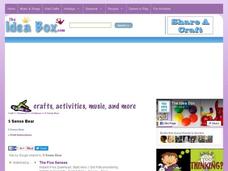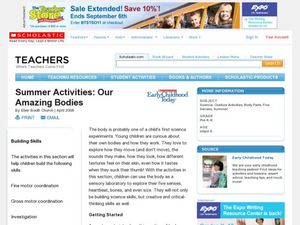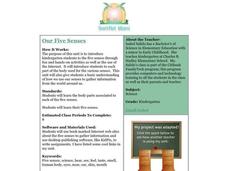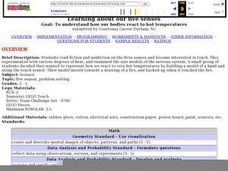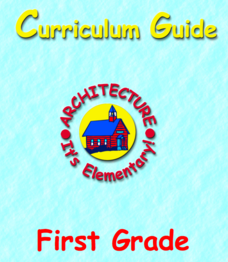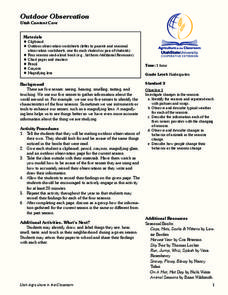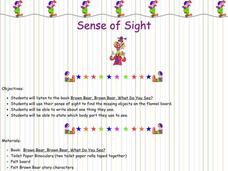Curated OER
Our Five Senses
Students are introduced to the five senses through tasks that require them to use each sense in isolation. Students discover how humans use their senses to learn more about their environment.
Curated OER
Drawing Upon Our Five Senses
Fifth graders identify the parts and functions of the body's five senses. In this biology lesson, 5th graders create a replica of the nervous system highlighting its parts. They create a scrapbook containing information on the senses...
Alabama Learning Exchange
The Five Senses: How They Relate to our World
Young scholars explore the five senses and the significance of each sense. In this five senses and diversity lesson, students listen to You Can't Smell a Flower With Your Ear by Joanna Cole and take a walk observing opportunities to use...
Curated OER
Making Sense of Our Senses
Students participate in activities about the five senses. They explore objects, listen to stories and discuss the senses with classmates.
Curated OER
5 Sense Bear
Students become familiar with their five senses through the creation of a sense bear. In this five senses lesson, students create a bear and add cinnamon and a candy cane to the bear. Students use their five senses with this...
Curated OER
The Five Senses
Students research the five senses and their location on the body using both literature and the Internet. They design a slideshow that highlights their research on the senses. They study how some people do not have all of their senses.
Curated OER
The Five Senses
Students participate in a scavenger hunt using their sense of sight. They bring various texture materials from home and discuss how things feel. Students identify the smells inside five jars. They discuss things they hear and why hearing...
Curated OER
Preschool Lesson Ideas: Human Body Lesson Plan and Five Senses Activities
Students explore their five senses. In this human biology lesson plan, students participate in various learning centers that include activities such as creating a Q-tip skeleton, feeling play dough, creating "goop" and listening to drum...
Curated OER
Summer Activities: Our Amazing Bodies
Students use the body as a sensory laboratory to explore their five senses, heartbeat, bones, and even size. For this early childhood science lesson, students build science and critical thinking skills as they take part in up to 6...
Curated OER
Our Five Senses
Students identify their five senses and how the are used everyday. As a class, they develop a list of sounds they hear at a zoo and compare them with a list of sounds they hear at a park or school. They create an instrument on their...
Curated OER
Using Our Senses
First graders explore the five senses. In this five senses activity, 1st graders use digital cameras to take pictures of things in nature they can hear, smell, see, taste or touch. Students create a slideshow and present to the...
Curated OER
Lesson Plan Five: Sense of Smell and The Nose
Students identify five different fruits by using their sense of smell, and then draw a picture of the fruit; students create their own picture, and add spices for scent.
Curated OER
Lesson Plan 12: Writing With All Your Senses
What does an ice cream sundae sound like? Challenge young writers to move beyond visual descriptions and craft details that appeal to all five senses. The examples provided by the script in this resource show pupils how to create rich...
Curated OER
Our Five Senses
Students explore the five senses through hands-on and Internet activities.
Curated OER
Lesson Plan Three: Sense of Hearing and The Ear
Students use their sense of hearing to observe sounds at school, label parts of the ear, and write their own version of the "Ears Hear" poem by following the example provided.
Curated OER
Learning About Our Five Senses
Students study the sense of touch and various degrees of heat. They design a model that displays how the human hand reacts to heat using a touch sensor.
Curated OER
Making Cents of the Senses
Students explore sight and hearing. In this senses lesson, students read Brown Bear Brown Bear, discuss how eyes are used for sight, and chart the eye color of the students in the class. Students discuss how hearing is important, take a...
American Institute of Architects
Architecture: It's Elementary!—First Grade
Build an interest and appreciation for architecture in your young learners with this fun 10-lesson art unit. Engaging children in using their five senses, the class first observes the environment around them, paying...
Curated OER
Outdoor Observation
Learners use observation materials to record what they find outdoors. In this senses lesson plan, students use their five senses to observe things outside. They use a clipboard, pencil, crayons, magnifying glass, and their senses to find...
Curated OER
My Favorite Room
Students practice describing a room. In this descriptive writing lesson plan, students use all of their five senses to describe their favorite room. The teacher will model for the class by creating a word list that describe the classroom...
Curated OER
Sense of Sight
Students examine the sense of sight. In this human biology instructional activity, students read the book Brown Bear, Brown Bear, What Do You See? and discuss all of the animals seen in the story. Students use binoculars and take several...
Curated OER
Sense of Touch
Students explore the sense of touch. They listen to and discuss the book, I Can Tell By Touching, observe a demonstration of cold, and create a touch book using candy buttons, pine needles, cotton, burlap, and wax paper.
Curated OER
Descriptive Writing: Using Art to Inspire description
Write with the senses! Try using art to inspire writers to consider all of the senses. Here, the class is divided in half. Each group looks at one of two images, imagines the senses that would be engaged, and records answers to five...
Curated OER
The Five Senses - Observation, Experimentation, Prediction, and Categorization.
First graders engage in this creative and well-designed lesson. They rotate through five learning stations, each devoted to one of the senses. They practice observation, experimentation, prediction, and categorization.




